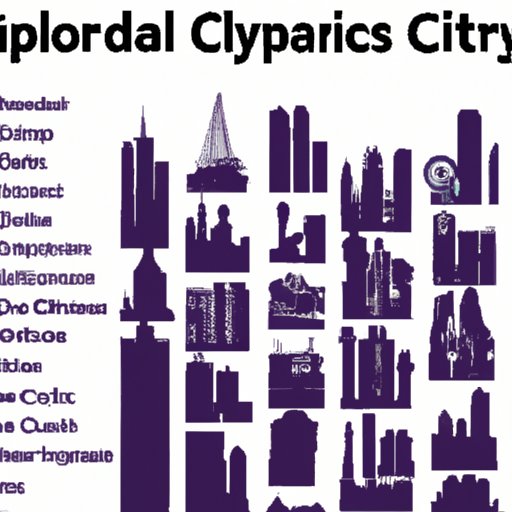Introduction
What is the biggest city in the world? The answer to this question depends on how we define “biggest.” Generally, when people refer to the world’s biggest city, they are referring to the city with the highest population. This article will explore the world’s largest cities from a variety of perspectives, including population, culture, infrastructure, and economics.
Ranking the World’s Largest Cities by Population
When ranking the world’s largest cities by population, it is important to consider the methodology used to compile the data. To determine the largest cities in the world, researchers have relied on a range of sources, including census data, population estimates, and satellite imagery.
The following list represents the world’s five largest cities according to population figures as of 2019: Tokyo (37 million), Delhi (29 million), Shanghai (26 million), Sao Paulo (22 million), and Mexico City (21 million).
A Historical Look at the Biggest Cities in the World
Throughout history, certain cities have been centers of power and commerce. Ancient cities such as Babylon, Rome, and Athens were home to some of the world’s earliest civilizations. These cities were hubs for trade, art, and culture.
In more recent centuries, the growth and decline of major cities has been influenced by a variety of factors, such as climate, geography, political systems, and technological advances. For instance, during the 19th century, London and Paris experienced rapid population growth due to industrialization. Similarly, in the 20th century, New York and Los Angeles emerged as centers of global influence.
Exploring the World’s Biggest Cities: A Cultural Perspective
The world’s largest cities are often associated with a rich cultural heritage. Major cities have been shaped by the diversity of their inhabitants. For example, Tokyo is known for its traditional Japanese culture, while London is renowned for its mix of cultures.
The world’s biggest cities are also home to a variety of different religions, languages, and customs. In many cases, these diverse cultures have coexisted peacefully. This has resulted in a unique blend of cultures that can be seen in the architecture, cuisine, and entertainment of the world’s largest cities.
Comparing and Contrasting the Infrastructure of the World’s Largest Cities
In addition to their cultural influences, the world’s largest cities are known for their advanced infrastructure. Many of the world’s biggest cities have extensive transportation networks, public services, communication systems, and education systems.
For example, Tokyo is home to an extensive subway system, while London has an efficient bus network. Additionally, cities like New York and Shanghai have invested heavily in building modern airports and seaports.
In terms of public services, many of the world’s largest cities have a wide range of health care facilities, libraries, and recreational centers. Furthermore, most of the world’s biggest cities have high-speed internet access and reliable telephone networks.
Examining the Changing Landscape of the World’s Biggest Cities
The world’s biggest cities have undergone dramatic changes over the last few decades. Urbanization has led to the growth of sprawling metropolises. At the same time, gentrification has brought about the transformation of neighborhoods.
Urbanization has had a significant impact on the environment, with increased air pollution and traffic congestion. Meanwhile, gentrification has caused the displacement of many long-term residents.
The Economic Impact of the World’s Largest Cities
The world’s largest cities are home to many of the world’s most powerful economies. These cities offer a variety of job opportunities and investment opportunities. Additionally, their global influence has made them key players in international affairs.
For example, Tokyo is a leading financial center, while London is a major hub for media and technology. Similarly, New York and Shanghai are major centers of trade and commerce.
Conclusion
This article has explored the world’s largest cities from a variety of perspectives, including population, culture, infrastructure, and economics. We have seen that these cities have a rich history and a diverse culture. Additionally, they have advanced infrastructure and a powerful economy. Finally, we have examined the changing landscape of these cities, and the impact that urbanization and gentrification have had on them.
In conclusion, the world’s largest cities are home to a wealth of opportunity and potential. They are living examples of the power of collaboration and cooperation. As our global population continues to grow, so too will the importance of the world’s biggest cities.


